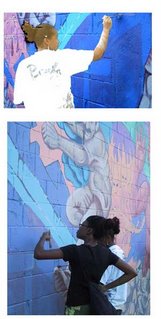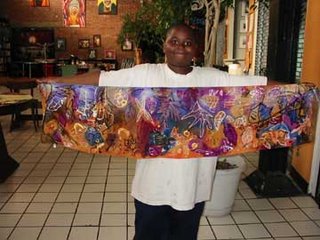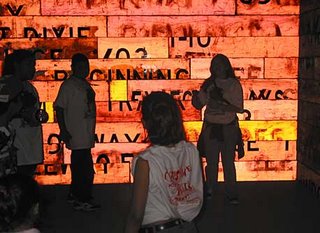 Last Friday I attended the Pratt Institute Center for Community Development "Art in the Contested City - A Conference Exploring the Role of the Arts in Contemporary Struggles over Urban Space." Which might prompt a couple of questions like, "Why isn't 'over' capitalized in the conference title?" and, "Why are you there?"
Last Friday I attended the Pratt Institute Center for Community Development "Art in the Contested City - A Conference Exploring the Role of the Arts in Contemporary Struggles over Urban Space." Which might prompt a couple of questions like, "Why isn't 'over' capitalized in the conference title?" and, "Why are you there?" I don't really have an answer to the first one, maybe a question of emphasis, and for the second question, I am here because I am interested in the role of art in social change, as well as artists working in communities which are not there own. The conference was very interesting, and only occassionally spiraled into a gentrification, anti development (Atlantic Yards, Williamsburg) rant. I would have liked to have seen more discussion on the role of individual artists in the community, but there were some really great organizations there and independent speakers. Sadly, I think they tried to cram waaaaay too much into one day, which meant that there really wasn't that much discussion and some very interesting ideas were only presented in a superficial manner.
I don't really have an answer to the first one, maybe a question of emphasis, and for the second question, I am here because I am interested in the role of art in social change, as well as artists working in communities which are not there own. The conference was very interesting, and only occassionally spiraled into a gentrification, anti development (Atlantic Yards, Williamsburg) rant. I would have liked to have seen more discussion on the role of individual artists in the community, but there were some really great organizations there and independent speakers. Sadly, I think they tried to cram waaaaay too much into one day, which meant that there really wasn't that much discussion and some very interesting ideas were only presented in a superficial manner.
A sampler from the day, and people from whom I would love to have heard more from...
- Ann Markusen, Professor, University of Minnesota, Director of H. Humphrey Institue’s Project on Regional and Industrial Economics, author of “ The Artistic Dividend: The Arts Hidden Contributions to Regional Development” (links to a PDF)
- Tom Borrup, Minneapolis-based consultant, and author of “Creative Tools for Community Building”
- Rick Lowe, Sculptor and activist, and founder of Project Row Houses in Houston and Commissioner on the Municipal Arts Commission of Houston
- Esther Robinson, former Program Director of Film/Video and Performing Arts, The Creative Capital Foundation, and founder of ArtHome
- Amy Sananman, Founder and Executive Director of Groundswell Community Mural Project

- Beka Economopoulos and Jason Jones, Artists, Not an Alternative
- Jonathan Lethem, Author and board member of Develop Don’t Destroy Brooklyn
- Kellie Terry-Sepulveda, Co-director of The Point, Bronx
- Rosten Woo, Designer, writer, policy analyst and principal at the Center for Urban Pedagogy
 I got to watch the documentary, "Third Ward, TX" which was about the development of Project Row Houses. I knew about the artist installations that happened in the row houses, but didn't realize how much Rick Lowe and the other founders had really put into the community. They developend a Young Mother's Residential Program, to help single mothers go to college. They created a number of educational programs for the kids in the neighborhood, and they have worked to buy land in the area to protect the neighborhood from development. If you get a change to see the documentary (when it is released - we saw a pre-screening) I highly recommend it, it is a fascinating study on how arts and artists can be used in social activism.
I got to watch the documentary, "Third Ward, TX" which was about the development of Project Row Houses. I knew about the artist installations that happened in the row houses, but didn't realize how much Rick Lowe and the other founders had really put into the community. They developend a Young Mother's Residential Program, to help single mothers go to college. They created a number of educational programs for the kids in the neighborhood, and they have worked to buy land in the area to protect the neighborhood from development. If you get a change to see the documentary (when it is released - we saw a pre-screening) I highly recommend it, it is a fascinating study on how arts and artists can be used in social activism.I also hope to talk to Amy Sanaman and Rosten Woo about their work in different communities, and how they created effective partnerships with local organizations. One of the issues I am sensitive to in creating the Sea Change project is going into a neighborhood that is not my own and being able to effectively communicate the relevant information (this is why the local partnerships are so important). Tom Finkelpearl, Director, Queens Museum of Art, moderated the discussion on Arts Organizations as Community Partners, and he believed that 'drop in community art' is possible if the artistic vision is clear enough. You can bet I will contact him about that.
11/10: I realize that the excerpt from this run on "No Land Grab:" makes it sound like I might somehow be in favor of the Ratner Atlantic Yards project. I want to be clear that I am definitely not in favor of the development as it currently stands.
I am in favor of massive overhaul of the 421 tax abatement program, and city requirements for additional low-income housing (affordable doesn't mean enough). I am opposed to the massive hulk of a development with unbelievably impermeable street surfaces.
I am in favor of a stringently green development with NO parking, improved transit (although it sits on top of one of the best transit hubs in the city), generous community and public open space, and a development designed with community input.



No comments:
Post a Comment